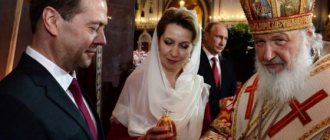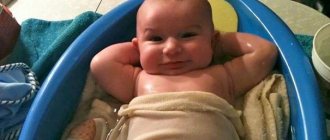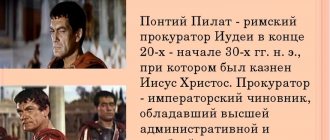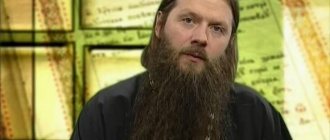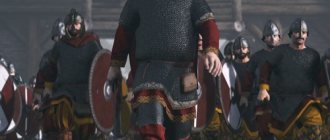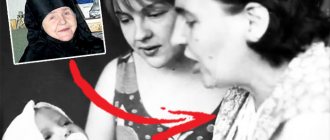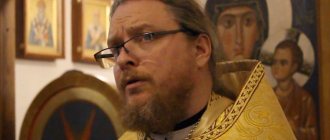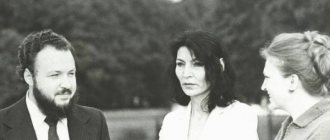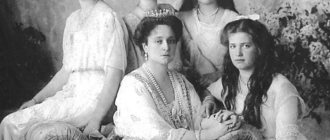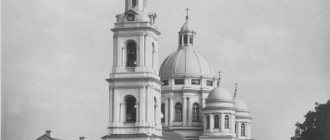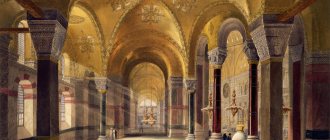Grand Duchess Sophia (1455–1503) of the Greek Palaiologan dynasty was the wife of Ivan III. She came from a line of Byzantine emperors. By marrying a Greek princess, Ivan Vasilyevich emphasized the connection between his own power and that of Constantinople. Once upon a time, Byzantium gave Christianity to Rus'. The marriage of Ivan and Sofia closed this historical circle. Their son Basil III and his heirs considered themselves successors to the Greek emperors. To transfer power to her own son, Sophia had to wage many years of dynastic struggle.
Origin
The exact date of birth of Sofia Paleolog is unknown. She was born around 1455 in the Greek city of Mystras. The girl’s father was Thomas Palaiologos, the brother of the last Byzantine emperor Constantine XI. He ruled the Despotate of Morea, located on the Peloponnese peninsula. Sophia's mother, Catherine of Achaia, was the daughter of the Frankish prince Achaea Centurion II (Italian by birth). The Catholic ruler conflicted with Thomas and lost a decisive war to him, as a result of which he lost his own possessions. As a sign of victory, as well as the annexation of Achaea, the Greek despot married Catherine.
The fate of Sofia Paleolog was determined by dramatic events that happened shortly before her birth. In 1453, the Turks captured Constantinople. This event marked the end of the thousand-year history of the Byzantine Empire. Constantinople was at the crossroads between Europe and Asia. Having occupied the city, the Turks opened their way to the Balkans and the Old World as a whole.
If the Ottomans defeated the emperor, then the other princes did not pose a threat to them at all. The Despotate of Morea was captured already in 1460. Thomas managed to take his family and flee from the Peloponnese. First, the Palaiologos came to Corfu, then moved to Rome. The choice was logical. Italy became the new home for many thousands of Greeks who did not want to remain under Muslim citizenship.
The girl's parents died almost simultaneously in 1465. After their death, the story of Sofia Paleolog turned out to be closely connected with the story of her brothers Andrei and Manuel. The young Palaiologos were sheltered by Pope Sixtus IV. In order to enlist his support and ensure a calm future for the children, Thomas, shortly before his death, converted to Catholicism, abandoning the Greek Orthodox faith.
Family of the future queen
The Greek version of the name Sophia Fominichna Paleolog is Zoya Paleologina. She was born around 1455 into the Palaiologan dynasty of Byzantine emperors. Her family was quite noble for that time:
- Father Thomas was the youngest son of the Byzantine emperor and despot (governor) of the province of Morea (the Peloponnese peninsula - an autonomous Greek entity within Byzantium) in 1428-1460. He was the legal heir of his older brother and could take the Byzantine throne.
- Father's brother (Sophia's uncle) Constantine XI was the eldest son of the emperor and ruled Byzantium in 1449-1453. He died during the capture of Constantinople by the Turkish wars. His niece was about 8 years old at the time.
- The mother was Catherine Tsakkaria, the daughter of the last king of Achaia.
- The mother's father (Sophia's grandfather) was Centurion II Tsaccaria, who belonged to a famous merchant family. The throne of Achaia passed to him from his father, who was assigned there by the Neapolitan king. In 1430, the Principality of Achaia was captured by Thomas Palaiologos. Centurion was forced to conclude a peace treaty with the enemy, the terms of which forced his daughter Catherine to marry Thomas. After Centurion's death, his lands passed to Thomas.
Princess Sophia also had an older sister, who became the wife of a Serbian despot, and two older brothers: Andrei and Mikhail. The first became despot of Morea after his father.
Life in Rome
The Greek scientist and humanist Vissarion of Nicea began training Sophia. Most of all, he was famous for being the author of the project for the union of the Catholic and Orthodox churches, concluded in 1439. For the successful reunification (Byzantium made this deal, being on the verge of destruction and hoping in vain for help from the Europeans), Vissarion received the rank of cardinal. Now he became the teacher of Sophia Paleologus and her brothers.
From an early age, the biography of the future Moscow Grand Duchess bore the stamp of Greco-Roman duality, of which Vissarion of Nicaea was an adherent. In Italy she always had a translator with her. Two professors taught her Greek and Latin. Sophia Palaiologos and her brothers were supported by the Holy See. Dad gave them more than 3 thousand ecus a year. Money was spent on servants, clothes, a doctor, etc.
The fate of Sofia's brothers turned out to be exactly the opposite of each other. As the eldest son of Thomas, Andrei was considered the legal heir of the entire Palaiologan dynasty. He tried to sell his status to several European kings, hoping that they would help him regain the throne. As expected, the crusade did not happen. Andrei died in poverty. Manuel returned to his historical homeland. In Constantinople, he began to serve the Turkish Sultan Bayezid II, and according to some sources, he even converted to Islam.
As a representative of the extinct imperial dynasty, Sophia Palaiologos from Byzantium was one of the most enviable brides in Europe. However, none of the Catholic monarchs with whom they tried to negotiate in Rome agreed to marry the girl. Even the glory of the Palaiologos name could not overshadow the danger posed by the Ottomans. It is precisely known that Sophia’s patrons began to match her with the Cypriot King Jacques II, but he responded with a firm refusal. Another time, the Roman Pontiff Paul II himself proposed the girl’s hand to the influential Italian aristocrat Caracciolo, but this attempt at a wedding also failed.
Embassy to Ivan III
In Moscow, they learned about Sofia in 1469, when the Greek diplomat Yuri Trachaniot arrived in the Russian capital. He proposed to the recently widowed but still very young Ivan III the project of marriage with the princess. The Roman Epistle delivered by the foreign guest was composed by Pope Paul II. The Pontiff promised Ivan support if he wanted to marry Sophia.
What made Roman diplomacy turn to the Moscow Grand Duke? In the 15th century, after a long period of political fragmentation and the Mongol yoke, Russia reunited and became a major European power. In the Old World there were legends about the wealth and power of Ivan III. In Rome, many influential people hoped for the help of the Grand Duke in the struggle of Christians against Turkish expansion.
One way or another, Ivan III agreed and decided to continue negotiations. His mother Maria Yaroslavna reacted favorably to the “Roman-Byzantine” candidacy. Ivan III, despite his tough temperament, was afraid of his mother and always listened to her opinion. At the same time, the figure of Sophia Palaeologus, whose biography was associated with the Latins, did not please the head of the Russian Orthodox Church, Metropolitan Philip. Realizing his powerlessness, he did not oppose the Moscow sovereign and distanced himself from the upcoming wedding.
Wedding
The Moscow embassy arrived in Rome in May 1472. The delegation was headed by the Italian Gian Batista della Volpe, known in Russia as Ivan Fryazin. The ambassadors were met by Pope Sixtus IV, who had recently replaced the deceased Paul II. As a token of gratitude for the hospitality shown, the pontiff received a large amount of sable fur as a gift.
Only a week passed, and a solemn ceremony took place in the main Roman Cathedral of St. Peter, at which Sophia Paleologus and Ivan III became engaged in absentia. Volpe played the role of groom. While preparing for an important event, the ambassador made a serious mistake. The Catholic rite required the use of wedding rings, but Volpe did not prepare them. The scandal was hushed up. All the influential organizers of the engagement wanted to complete it safely and turned a blind eye to the formalities.
In the summer of 1472, Sophia Paleologus, together with her retinue, the papal legate and Moscow ambassadors, set off on a long journey. At parting, she met with the pontiff, who gave the bride his final blessing. Of several routes, Sofia's companions chose the path through Northern Europe and the Baltics. The Greek princess crossed the entire Old World, coming from Rome to Lubeck. Sofia Palaeologus from Byzantium endured the hardships of a long journey with dignity - such trips were not the first time for her. At the insistence of the pope, all Catholic cities organized a warm welcome for the embassy. The girl reached Tallinn by sea. This was followed by Yuryev, Pskov, and then Novgorod. Sofia Paleolog, whose appearance was reconstructed by specialists in the 20th century, surprised Russians with her foreign southern appearance and unfamiliar habits. Everywhere the future Grand Duchess was greeted with bread and salt.
On November 12, 1472, Princess Sophia Paleologus arrived in the long-awaited Moscow. The wedding ceremony with Ivan III took place on the same day. There was an understandable reason for the rush. Sophia's arrival coincided with the celebration of the day of memory of John Chrysostom, the patron saint of the Grand Duke. So the Moscow sovereign gave his marriage under heavenly protection.
For the Orthodox Church, the fact that Sofia was the second wife of Ivan III was reprehensible. A priest who would officiate such a marriage had to risk his reputation. In addition, the attitude towards the bride as a foreign Latina has been entrenched in conservative circles since her appearance in Moscow. That is why Metropolitan Philip avoided the obligation to perform the wedding. Instead, the ceremony was led by Archpriest Hosiya of Kolomna.
Sophia Palaeologus, whose religion remained Orthodox even during her stay in Rome, nevertheless arrived with the papal legate. This envoy, traveling along Russian roads, demonstratively carried in front of him a large Catholic crucifix. Under pressure from Metropolitan Philip, Ivan Vasilyevich made it clear to the legate that he was not going to tolerate such behavior that embarrassed his Orthodox subjects. The conflict was settled, but “Roman glory” haunted Sophia until the end of her days.
Sofia Paleolog: genius and villainy
Start over. Sophia, or in infancy Zoya, was born into the family of Thomas Palaiologos, the despot of the Morea. He was the younger brother of the last Byzantine emperor, Constantine XI, who died during the fall of Constantinople in the mid-15th century.
It is after this phrase that sometimes chaos begins in people’s thinking. Well, if the father is a despot, then who should the daughter be? And a hail of accusations begins. Meanwhile, if we show a little curiosity and look into the dictionary, which does not always interpret words in monosyllables, then we can read something different about the word “despot”.
It turns out that the highest-ranking Byzantine nobles were called despots. And despotates are divisions in the state, similar to modern provinces or states. So Sofia’s father was a nobleman who led one of these pieces of the state - a despotate.
She was not the only child in the family - she had two more brothers: Manuel and Andrey. The family professed Orthodoxy, the mother of the children, Ekaterina Akhaiskaya, was a very church-going woman, which she taught her children.
But the years were very difficult. The Byzantine Empire was on the verge of collapse. And when Constantine XI died and the capital was captured by the Turkish Sultan Mehmed II, the Paleologus family was forced to flee their family nest. They first settled on the island of Corfu and later moved to Rome.
In Rome, children were orphaned. First, the mother died, and then, six months later, Thomas Paleologus also went to the Lord. The education of orphans was taken up by the Greek scientist, Uniate Vissarion of Nicea, who served as a cardinal under Pope Sixtus IV (yes, he was the one who ordered the construction of the chapel, which now bears his name - the Sistine).
And naturally, Zoya and her brothers were raised Catholic. But at the same time, the children also received a good education. They knew Latin and Greek, mathematics and astronomy, and spoke several languages fluently.
The Pope showed such virtue not only out of compassion for orphans. His thoughts were much more pragmatic. In order to restore the Florentine union of churches and join the Moscow state to the union, he decided to marry Sophia Paleologus to the Russian prince Ivan III, who had recently been a widower.
The widowed prince liked the Pope's desire to unite the ancient Moscow family with the famous Paleologus family. But he himself could not decide anything. Ivan III asked his mother for advice on what to do. The offer was tempting, but he understood perfectly well that not only his personal fate was at stake, but also the fate of the state, whose ruler he would become. His father, Grand Duke Vasily II of Moscow, nicknamed the Dark One because of his blindness, appointed his 16-year-old son as his co-ruler. And at the time of the alleged matchmaking, Vasily II had already died.
The mother sent her son to Metropolitan Philip. He spoke out sharply against the upcoming marriage and did not give his highest blessing to the prince. As for Ivan III himself, he liked the idea of marriage with a Byzantine princess. Indeed, by doing so, Moscow became the heir of Byzantium - the “third Rome”, which incredibly strengthened the authority of the Grand Duke not only in his own country, but also in relations with neighboring states.
After some thought, he sent his ambassador to Rome, the Italian Jean-Baptiste della Volpe, who in Moscow was called much more simply: Ivan Fryazin. His personality is very interesting. He was not only the main minter of coins at the court of Grand Duke Ivan III, but also the tax farmer of this very profitable business. But that’s not what we’re talking about now.
The wedding agreement was concluded, and Sofia, along with several accompanying persons, left Rome for Russia.
She crossed all of Europe. In all the cities where she stopped, she was given a magnificent reception and showered with souvenirs. The last stop before arriving in Moscow was the city of Novgorod. And then an unpleasant event happened.
In Sofia's train there was a large Catholic cross. The news of this reached Moscow and incredibly upset Metropolitan Philip, who had not given his blessing to this marriage anyway. Bishop Philip gave an ultimatum: if the cross is brought to Moscow, he will leave the city. Things were getting serious. The envoy of Ivan III acted simply in Russian: having met a convoy at the entrance to Moscow, he took and took away the cross from the representative of the Pope, who accompanied Sophia Palaeologus. Everything was decided quickly and without unnecessary fuss.
Directly on the day of her arrival in Belokamennaya, namely November 12, 1472, as the chronicles of that time testify, her wedding took place with Ivan III. It took place in a temporary wooden church, erected near the Assumption Cathedral under construction, so as not to stop the services. Metropolitan Philip, still beside himself with rage, refused to perform the wedding ceremony. And this sacrament was performed by Kolomna Archpriest Josiah, who was specially urgently invited to Moscow. Sofia Paleolog became the wife of Ivan III. But, to the great misfortune and disappointment of the Pope, everything turned out completely differently than he expected.
According to legend, she brought with her a “bone throne” as a gift to her husband: its wooden frame was entirely covered with plates of ivory and walrus ivory with scenes on biblical themes carved on them. Sophia also brought with her several Orthodox icons.
Sofia, whose goal was to persuade Rus' to Catholicism, became Orthodox. The angry ambassadors of the union left Moscow with nothing. A number of historians are inclined to believe that Sophia secretly communicated with the Athonite elders, learning the basics of the Orthodox faith, which she liked more and more. There is evidence that several people of other faiths approached her, whom she refused solely because of differences in religious views.
“The double-headed eagle, the dynastic sign of the Paleologus family, becomes a visible sign of the continuity of Rus' from Byzantium”
Be that as it may, Paleologue became the Grand Russian Duchess Sophia Fominichnaya. And she didn’t just become one formally. She brought with her a great baggage to Rus' - the covenants and traditions of the Byzantine Empire, the so-called “symphony” of state and church power. And these were not just words. A visible sign of the continuity of Rus' from Byzantium becomes the double-headed eagle - the dynastic sign of the Paleologus family. And this sign becomes the state emblem of Rus'. A little later, a horseman was added to it, striking a serpent with a sword - Saint George the Victorious, who used to be the coat of arms of Moscow.
The husband listened to the wise advice of his enlightened wife, although his boyars, who previously had undivided influence over the prince, did not like this.
And Sofia became not only her husband’s assistant in government affairs, but also the mother of a huge family. She gave birth to 12 children, 9 of whom lived long lives. First, Elena was born, who died in early infancy. Fedosia followed her, followed by Elena again. And finally - happiness! Heir! On the night of March 25-26, 1479, a boy was born, named Vasily in honor of his grandfather. Sofia Paleologus had a son, Vasily, the future Vasily III. For his mother, he always remained Gabriel - in honor of the Archangel Gabriel, to whom she tearfully prayed for the gift of an heir.
Fate also gave the couple Yuri, Dmitry, Evdokia (who also died as an infant), Ivan (who died as a child), Simeon, Andrei, again Evdokia and Boris.
Immediately after the birth of the heir, Sofia Paleologus ensured that he was declared Grand Duke. With this action, she practically ousted Ivan III’s eldest son from a previous marriage, Ivan (Young), from the line for the throne, and after him, his son, that is, Ivan III’s grandson, Dmitry.
Naturally, this led to all sorts of rumors. But it seemed that the Grand Duchess did not care about them at all. She was worried about something completely different.
Sofia Paleolog insisted that her husband surround himself with pomp, wealth and establish etiquette at court. These were the traditions of the empire, and they had to be observed. From Western Europe, Moscow was flooded with doctors, artists, builders, architects... They were given an order - to decorate the capital!
Aristotle Fioravanti was invited from Milan, who was charged with the task of building the Kremlin chambers. The choice was not accidental. Signor Aristotle was known as an excellent specialist in underground passages, hiding places and labyrinths.
And before laying the walls of the Kremlin, he built real catacombs under them, in one of the casemates of which a real treasury was hidden - a library in which manuscripts from antiquity and volumes saved from the fire of the famous Library of Alexandria were kept. Remember, on the Feast of the Presentation we talked about Simeon the God-Receiver? His translation of the book of the prophet Isaiah into Greek was kept in this library.
In addition to the Kremlin chambers, the architect Fioravanti built the Assumption and Annunciation Cathedrals. Thanks to the skill of other architects, the Faceted Chamber, the Kremlin towers, the Terem Palace, the State Court and the Archangel Cathedral appeared in Moscow. Moscow became more and more beautiful every day, as if preparing to become royal.
But this was not the only thing our heroine cared about. Sofia Paleologus, having great influence on her husband, who saw in her a reliable friend and wise adviser, convinced him to refuse to pay tribute to the Golden Horde. Ivan III finally threw off this long-term yoke. But the boyars were very afraid that the horde would go wild when they learned about the prince’s decision, and bloodshed would begin. But Ivan III was firm, enlisting the support of his wife.
Well. For now, we can say that Sofia Paleologus was a kind genius both for her husband and for Mother Rus'. But we forgot about one person who didn’t think so at all. This man's name is Ivan. Ivan the Young, as he was called at court. And he was the son from the first marriage of Grand Duke Ivan III.
After Sophia's son Palaeologus was declared heir to the throne, the Russian nobility at court split. Two groups formed: one supported Ivan the Young, the other supported Sophia.
From the very moment of his appearance at court, Ivan the Young did not have a good relationship with Sophia, and she did not try to improve it, being busy with other state and personal affairs. Ivan Young was only three years younger than his stepmother, and like all teenagers, he was jealous of his father for his new lover. Soon Ivan the Young married the daughter of the ruler of Moldavia, Stephen the Great, Elena Voloshanka. And at the time of the birth of his half-brother, he himself was the father of Dmitry’s son.
Ivan the Young, Dmitry... Vasily’s chances of taking the throne were very slim. And this did not suit Sofia Paleolog. It didn't suit me at all. Two women - Sofia and Elena - became sworn enemies and simply burned with the desire to get rid of not only each other, but also the offspring of their rival. And Sofia Paleologus makes a mistake. But about this in order.
The Grand Duchess maintained very warm and friendly relations with her brother Andrei. His daughter Maria married Prince Vasily Vereisky in Moscow, who was the nephew of Ivan III. And one day, without asking her husband, Sofia gave her niece a jewel that once belonged to the first wife of Ivan III.
And the Grand Duke, seeing his daughter-in-law’s hostility towards his wife, decided to appease her and give her this family jewel. This is where the great failure occurred! The prince was beside himself with anger! He demanded that Vasily Vereisky immediately return the heirloom to him. But he refused. They say it's a gift, sorry! Moreover, its cost was very, very impressive.
Ivan III was simply furious and ordered Prince Vasily Vereisky and his wife to be thrown into prison! The relatives had to hastily flee to Lithuania, where they escaped the wrath of the sovereign. But the prince was angry with his wife for this act for a long time.
By the end of the 15th century, passions in the grand ducal family had subsided. At least the appearance of a cold world remained. Suddenly a new misfortune struck: Ivan Molodoy fell ill with aching legs and was practically paralyzed. The best doctors from Europe were quickly prescribed to him. But they could not help him. Soon Ivan Molodoy died.
The doctors, as usual, were executed... But in the circle of boyars, the rumor began to emerge more and more clearly that Sofia Paleologus had a hand in the death of the heir. They say she poisoned her competitor Vasily. Rumor reached Ivan III that some dashing women came to Sofia with a potion. He flew into a rage, did not even want to see his wife, and ordered his son Vasily to be kept in custody. The women who came to Sophia were drowned in the river, many were thrown into prison. But Sofia Paleolog did not stop there.
After all, Ivan the Young left an heir, known as Dmitry Ivanovich Grandson. Grandson of Ivan III. And on February 4, 1498, at the end of the 15th century, he was officially proclaimed heir to the throne.
But you have a bad idea of the personality of Sophia Paleologue if you think that she has resigned herself. Quite the opposite.
At that time, the Judaizing heresy began to spread in Rus'. She was brought to Rus' by some Kiev Jewish scientist named Skhariya. He began to reinterpret Christianity in the Jewish manner, denied the Holy Trinity, put the Old Testament above the New, rejected the veneration of icons and relics of saints... In general, in modern terms, he gathered sectarians like him who had broken away from holy Orthodoxy. Elena Voloshanka and Prince Dmitry somehow joined this sect.
This was a great trump card in the hands of Sofia Paleolog. Immediately, Ivan III was reported about sectarianism. And Elena and Dmitry fell into disgrace. Sofia and Vasily again took their previous position. From that time on, the sovereign began, according to the chroniclers, “not to care about his grandson,” and declared his son Vasily the Grand Duke of Novgorod and Pskov. Sofia achieved that it was ordered to keep Dmitry and Elena in custody, not to remember them at litanies in the church and not to call Dmitry the Grand Duke.
Sophia Paleologus, who actually won the royal throne for her son, did not live to see this day. She died in 1503. Elena Voloshanka also died in prison.
Thanks to the method of plastic reconstruction based on the skull, at the end of 1994 the sculptural portrait of Grand Duchess Sophia Paleologue was restored. She was short - about 160 cm, plump, with strong-willed features and had a mustache that did not spoil her at all.
Ivan III, already feeling weak in health, prepared a will. It lists Vasily as heir to the throne.
Meanwhile, the time has come for Vasily to get married. An attempt to marry him to the daughter of the Danish king failed; then, on the advice of one courtier, a Greek, Ivan Vasilyevich followed the example of the Byzantine emperors. It was ordered to bring the most beautiful maidens, daughters of boyars and boyar children to the court for the viewing. One and a half thousand of them were collected. Vasily chose Solomonia, the daughter of the nobleman Saburov.
After the death of his wife, Ivan Vasilyevich lost heart and became seriously ill. Apparently, Grand Duchess Sophia gave him the necessary energy to build a new power, her intelligence helped in state affairs, her sensitivity warned of dangers, her all-conquering love gave him strength and courage. Leaving all his affairs, he went on a trip to the monasteries, but failed to atone for his sins. He was paralyzed. On October 27, 1505, he departed to the Lord, outliving his beloved wife by only two years.
Vasily III, having ascended the throne, first of all tightened the conditions of detention for his nephew, Dmitry Vnuk. He was shackled and placed in a small, stuffy cell. In 1509 he died.
Vasily and Solomonia had no children. On the advice of those close to him, he married Elena Glinskaya. On August 25, 1530, Elena Glinskaya gave birth to an heir, Vasily III, who was named John at baptism. Then there was a rumor that when he was born, a terrible thunder rolled across the entire Russian land, lightning flashed and the earth shook...
Ivan the Terrible was born, as modern scientists say, in appearance very similar to his grandmother, Sofia Palaeologus. Ivan the Terrible is a maniac, sadist, libertine, despot, alcoholic, the first Russian Tsar and the last in the Rurik dynasty. Ivan the Terrible, who took the schema on his deathbed and was buried in a cassock and doll. But that's a completely different story.
And Sophia Paleologus was buried in a massive white-stone sarcophagus in the tomb of the Ascension Cathedral in the Kremlin. Next to her lay the body of Ivan III’s first wife, Maria Borisovna. This cathedral was destroyed in 1929 by the new government. But the remains of the women of the royal house have been preserved. They now rest in the underground chamber of the Archangel Cathedral.
This was the life of Sophia Paleolog. Virtue and villainy, genius and meanness, the decoration of Moscow and the destruction of competitors - everything was in her difficult, but very bright biography.
Who she is - the embodiment of evil and intrigue or the creator of a new Muscovy - is up to you, the reader, to decide. In any case, her name is inscribed in the annals of history, and we still see part of her family coat of arms - a double-headed eagle - on Russian heraldry today.
One thing is certain - she made a huge contribution to the history of the Moscow Principality. May he rest in peace! The mere fact that she did not allow Moscow to become a Catholic state is priceless for us Orthodox!
The main photo is the meeting of Princess Sofia Palaeolog by Pskov mayors and boyars at the mouth of the Embakh on Lake Peipus. Bronnikov F.A.
You can applaud the author (at least 10 times)76
Historical role
Together with Sofia, her Greek retinue came to Russia. Ivan III was very interested in the heritage of Byzantium. The marriage to Sophia became a signal for many other Greeks wandering in Europe. A stream of co-religionists arose who sought to settle in the possessions of the Grand Duke.
What did Sofia Paleolog do for Russia? She opened it to Europeans. Not only Greeks, but also Italians went to Muscovy. Masters and learned people were especially valued. Ivan III patronized Italian architects (for example, Aristotle Fioravanti), who built a large number of architectural masterpieces in Moscow. A separate courtyard and mansions were built for Sophia herself. They burned down in 1493 during a terrible fire. The Grand Duchess's treasury was lost along with them.
Influence on politics and culture
Contemporaries noted that Ivan III, after marrying the niece of the Byzantine emperor, appeared as a formidable sovereign on the Moscow grand-ducal table. The Byzantine princess brought sovereign rights to her husband and, according to the Byzantine historian F.I. Uspensky, the right to the throne of Byzantium, which the boyars had to reckon with. Previously, Ivan III loved “meeting against himself,” that is, objections and disputes, but under Sophia he changed his treatment of the courtiers, began to behave inaccessibly, demanded special respect and easily fell into anger, every now and then inflicting disgrace. These misfortunes were also attributed to the harmful influence of Sophia Paleologus.
An attentive observer of Moscow life, Baron Herberstein, who came to Moscow twice as an ambassador of the German Emperor during the reign of Vasily III, having heard enough boyar talk, notes about Sophia in his notes that she was an unusually cunning woman who had great influence on the Grand Duke, who, at her suggestion, made much. Finally, the chroniclers confirm this, saying, for example, that according to the suggestions of Sophia, Ivan III finally broke with the Horde. As if she once said to her husband: “ I refused my hand to rich, strong princes and kings, for the sake of faith I married you, and now you want to make me and my children tributaries; Don't you have enough troops?
»
As a princess, Sofia enjoyed the right to receive foreign embassies in Moscow. According to the legend cited not only by Russian chronicles, but also by the English poet John Milton, in 1477 Sofia was able to outwit the Tatar khan by declaring that she had a sign from above about the construction of a temple to St. Nicholas on the spot in the Kremlin where the house of the khan’s governors, who controlled the fees, stood tribute and the actions of the Kremlin. This story presents Sophia as a decisive person (“ she kicked them out of the Kremlin, demolished the house, although she did not build a temple
"). Ivan III really refused to pay tribute and trampled on the Khan’s letter right at the Horde court in Zamoskvorechye; Rus' actually stopped paying tribute to the Horde.
Sophia managed to attract doctors, cultural figures and especially architects to Moscow. The creations of the latter could make Moscow equal in beauty and majesty to European capitals and support the prestige of the Moscow sovereign, as well as emphasize the continuity of Moscow not only with the Second, but also with the First Rome. Arriving architects Aristotle Fioravanti, Marco Ruffo, Aleviz Fryazin, Antonio and Petro Solari erected the Faceted Chamber in the Kremlin, the Assumption and Annunciation Cathedrals on the Kremlin Cathedral Square; The construction of the Archangel Cathedral was completed.
All five embassies that the Grand Duke sent to Italy at the end of the century returned to Moscow, accompanied by architects and doctors, jewelers and moneymakers, specialists in the field of weapons and serfdom. The Greek and Italian nobility, whose representatives worked in the diplomatic service, flocked to Moscow; many of them settled in Rus'.
The marriage of Ivan III and Sophia Paleologus undoubtedly strengthened the Muscovite state, contributing to its conversion to the great Third Rome.
Sophia died on August 7, 1503 in Moscow. She was buried in the Moscow Ascension nunnery of the Kremlin.
In December 1994, in connection with the transfer of the remains of the princes and royal wives to the basement chamber of the Archangel Cathedral, S.A. Nikitin restored her sculptural portrait using the well-preserved skull of Sophia.
During the days of standing on the Ugra
In 1480, Ivan III escalated the conflict with the Tatar Khan Akhmat. The result of this conflict is known - after a bloodless stand on the Ugra, the Horde left Russia and never again demanded tribute from it. Ivan Vasilyevich managed to throw off the long-term yoke. However, before Akhmat left the possessions of the Moscow prince in disgrace, the situation seemed uncertain. Fearing an attack on the capital, Ivan III organized the departure of Sophia and their children to White Lake. Together with his wife there was the grand ducal treasury. If Akhmat had captured Moscow, she should have fled further north closer to the sea.
The decision to evacuate, which was made by Ivan 3 and Sofia Paleolog, caused outrage among the people. Muscovites began to recall with pleasure the “Roman” origins of the princess. Sarcastic descriptions of the empress's flight to the north were preserved in some chronicles, for example in the Rostov vault. Nevertheless, all the reproaches of his contemporaries were immediately forgotten after the news arrived in Moscow that Akhmat and his army had decided to retreat from the Ugra and return to the steppes. Sofia from the Paleolog family arrived in Moscow a month later.
Perestroika of the 15th century
Sophia inspired her husband that the sovereign of such a great power as he could not live in a capital with wooden churches and chambers. Under the influence of his wife, Ivan III began rebuilding the Kremlin. The architect Aristotle Fioravanti was invited from Italy to build the Assumption Cathedral . White stone was actively used at the construction site, which is why the expression “white stone Moscow”, which has survived for centuries, appeared.
A silent witness to history. 535 years of the oldest church in Russia
More details
Inviting foreign specialists in various fields has become a widespread phenomenon under Sophia Paleolog. The Italians and Greeks, who took up the positions of ambassadors under Ivan III, will begin to actively invite their fellow countrymen to Russia: architects, jewelers, coiners and gunsmiths. Among the visitors there were a large number of professional doctors.
Article on the topic
The secret of Ivan the Terrible's library has not been solved
Sophia arrived in Moscow with a large dowry, part of which was occupied by a library, which included Greek parchments, Latin chronographs, ancient Eastern manuscripts, including poems by Homer , works by Aristotle and Plato , and even books from the Library of Alexandria.
These books formed the basis of the legendary missing library of Ivan the Terrible, which enthusiasts are trying to search for to this day. Skeptics, however, believe that such a library did not actually exist.
Speaking about the hostile and wary attitude of the Russians towards Sophia, it must be said that they were embarrassed by her independent behavior and active interference in state affairs. Such behavior was uncharacteristic for Sophia’s predecessors as grand duchesses, and simply for Russian women.
Question answer
Ivan groznyj. Special signs. Infographics
The heir problem
Ivan and Sofia had 12 children. Half of them died in childhood or infancy. The remaining grown children of Sofia Paleolog also left behind offspring, but the Rurik branch, which began from the marriage of Ivan and the Greek princess, died out around the middle of the 17th century. The Grand Duke also had a son from his first marriage to the Tver princess. Named after his father, he is remembered as Ivan Mladoy. According to the law of seniority, it was this prince who was supposed to become the heir to the Moscow state. Of course, Sofia did not like this scenario, who wanted power to pass to her son Vasily. A loyal group of court nobility formed around her, supporting the princess’s claims. However, for the time being, she could not influence the dynastic issue in any way.
Since 1477, Ivan the Young was considered his father's co-ruler. He took part in the battle on the Ugra and gradually learned princely duties. For many years, Ivan the Young's position as the rightful heir was undeniable. However, in 1490 he fell ill with gout. There was no cure for “ache in the legs.” Then the Italian doctor Mister Leon was discharged from Venice. He undertook to cure the heir and vouched for success with his own head. Leon used rather strange methods. He gave Ivan a certain potion and burned his legs with red-hot glass vessels. The treatment only made the illness worse. In 1490, Ivan the Young died in terrible agony at the age of 32. In anger, Sophia's husband Paleologus imprisoned the Venetian, and a few weeks later he publicly executed him.
How Sophia saved Russia from the yoke
Their marriage lasted 30 years, she bore her husband 12 children, of whom five sons and four daughters lived to adulthood. Judging by historical documents, the Grand Duke was attached to his wife and children, for which he even received reproaches from high-ranking church officials who believed that this was detrimental to state interests.
Article on the topic
Symbol of unity. Where did the double-headed eagle appear on the coat of arms of Russia?
Sophia never forgot about her origin and behaved as, in her opinion, the emperor’s niece should behave. Under her influence, the receptions of the Grand Duke, especially the receptions of ambassadors, were furnished with a complex and colorful ceremony, similar to the Byzantine one. Thanks to her, the Byzantine double-headed eagle migrated to Russian heraldry. Thanks to her influence, Grand Duke Ivan III began to call himself the “Russian Tsar.” With the son and grandson of Sophia Paleologus, this designation of the Russian ruler will become official.
Judging by the actions and deeds of Sophia, she, having lost her native Byzantium, seriously took up the task of building it in another Orthodox country. She was helped by her husband’s ambition, on which she successfully played.
When the Horde Khan Akhmat was preparing an invasion of Russian lands and in Moscow they were discussing the issue of the amount of tribute with which one could buy off misfortune, Sophia intervened in the matter. Bursting with tears, she began to reproach her husband for the fact that the country was still forced to pay tribute and that it was time to end this shameful situation. Ivan III was not a warlike man, but his wife’s reproaches touched him to the quick. He decided to gather an army and march towards Akhmat.
Article on the topic
The brilliant plan of Ivan the Great. How standing on the Ugra put an end to the yoke
At the same time, the Grand Duke sent his wife and children first to Dmitrov, and then to Beloozero, fearing military failure.
But there was no failure - there was no battle on the Ugra River, where the troops of Akhmat and Ivan III met. After what is known as the “standing on the Ugra,” Akhmat retreated without a fight, and his dependence on the Horde ended completely.
Conflict with Elena
The death of Ivan the Young did not bring Sofia much closer to the fulfillment of her dream. The deceased heir was married to the daughter of the Moldavian sovereign, Elena Stefanovna, and had a son, Dmitry. Now Ivan III faced a difficult choice. On the one hand, he had a grandson, Dmitry, and on the other, a son from Sofia, Vasily.
For several years, the Grand Duke continued to hesitate. The boyars split again. Some supported Elena, others - Sofia. The first had significantly more supporters. Many influential Russian aristocrats and nobles did not like the story of Sophia Paleologus. Some continued to reproach her for her past with Rome. In addition, Sofia herself tried to surround herself with her native Greeks, which did not benefit her popularity.
On the side of Elena and her son Dmitry there was a good memory of Ivan the Young. Vasily’s supporters resisted: on his mother’s side, he was a descendant of the Byzantine emperors! Elena and Sofia were worth each other. Both of them were distinguished by ambition and cunning. Although the women observed palace decorum, their mutual hatred of each other was no secret to the princely entourage.
Personal life
Apparently, Sophia Paleologue’s personal life with Grand Duke Ivan III was successful. This marriage produced a significant number of offspring - 5 sons and 4 daughters. But it’s difficult to call the existence of the new Grand Duchess Sophia in Moscow cloudless. The boyars saw the enormous influence that the wife had on her husband. Many people didn't like it.
Vasily III, son of Sophia Paleologus
Rumor has it that the princess had a bad relationship with the heir born in the previous marriage of Ivan III, Ivan the Young. Moreover, there is a version that Sophia was involved in the poisoning of Ivan the Young and the further removal from power of his wife Elena Voloshanka and son Dmitry.
Be that as it may, Sophia Paleologus had a huge influence on the entire subsequent history of Rus', on its culture and architecture. She was the mother of the heir to the throne, Vasily III, and the grandmother of Ivan the Terrible. According to some reports, the grandson bore considerable resemblance to his wise Byzantine grandmother.
Opal
In 1497, Ivan III became aware of a conspiracy being prepared behind his back. Young Vasily fell under the influence of several careless boyars. Fyodor Stromilov stood out among them. This clerk was able to assure Vasily that Ivan was already going to officially declare Dmitry his heir. Reckless boyars suggested getting rid of their competitor or seizing the sovereign's treasury in Vologda. The number of like-minded people involved in the venture continued to grow until Ivan III himself found out about the conspiracy.
As always, the Grand Duke, terrible in anger, ordered the execution of the main noble conspirators, including clerk Stromilov. Vasily escaped prison, but guards were assigned to him. Sofia also fell into disgrace. Her husband heard rumors that she was bringing imaginary witches to her place and was trying to get a potion to poison Elena or Dmitry. These women were found and drowned in the river. The Emperor forbade his wife to come into his sight. To top it off, Ivan actually declared his fifteen-year-old grandson his official heir.
The fight continues
In February 1498, celebrations were held in Moscow to mark the coronation of young Dmitry. The ceremony in the Assumption Cathedral was attended by all the boyars and members of the grand ducal family with the exception of Vasily and Sofia. The disgraced relatives of the Grand Duke were pointedly not invited to the coronation. The Monomakh Cap was put on Dmitry, and Ivan III arranged a grand feast in honor of his grandson.
Elena's party could triumph - this was her long-awaited triumph. However, even supporters of Dmitry and his mother could not feel too confident. Ivan III was always distinguished by impulsiveness. Because of his tough temperament, he could throw anyone into disgrace, including his wife, but nothing guaranteed that the Grand Duke would not change his preferences.
A year has passed since Dmitry's coronation. Unexpectedly, the sovereign's favor returned to Sophia and her eldest son. There is no evidence in the chronicles about the reasons that prompted Ivan to reconcile with his wife. One way or another, the Grand Duke ordered the case against his wife to be reconsidered. During the repeated investigation, new circumstances of the court struggle were discovered. Some denunciations against Sofia and Vasily turned out to be false.
The sovereign accused the most influential defenders of Elena and Dmitry - princes Ivan Patrikeev and Simeon Ryapolovsky - of slander. The first of them was the chief military adviser to the Moscow ruler for more than thirty years. Ryapolovsky's father defended Ivan Vasilyevich as a child when he was in danger from Dmitry Shemyaka during the last Russian internecine war. These great merits of the nobles and their families did not save them.
Six weeks after the boyars' disgrace, Ivan, who had already returned favor to Sofia, declared their son Vasily the prince of Novgorod and Pskov. Dmitry was still considered the heir, but members of the court, sensing a change in the sovereign’s mood, began to abandon Elena and her child. Fearing the same fate as Patrikeev and Ryapolovsky, other aristocrats began to demonstrate loyalty to Sofia and Vasily.
short biography
In 1467, Moscow Prince Ivan . For dad, he became a very suitable candidate as a groom for Sophia. With its help, Rome hoped to strengthen Catholicism among the Russian people. On February 11, 1469, an ambassador from the pope arrived in Moscow to negotiate the wedding.
- June 1, 1472 in the Basilica of St. Peter and Paul, finally, the ceremony of betrothal in absentia took place between Sophia Paleolog and Moscow Prince Ivan III.
- The wedding was postponed for so long because the Moscow Metropolitan Philip objected to this marriage, rightly fearing the spread of Catholicism in Rus'.
- On June 24, 1472, Sophia, together with Cardinal Vissarion of Nicea, who was entrusted with the mission of strengthening the position of the Catholic Church in Russia, left for Moscow. After a long journey, they arrived in November.
- It is worth mentioning that Sofia brought many books, manuscripts, paintings, and Orthodox icons to Moscow. Chroniclers say that her entire dowry was placed on more than 70 carts.
- Then it turned out that Sophia Paleologue again converted to Orthodoxy. This was an unpleasant surprise for the Catholic priests accompanying her.
- On November 22, 1472, the wedding of Sophia and Ivan III took place in the Assumption Cathedral. Sophia Paleologus now became the Grand Duchess of Moscow.
- 1474. The cathedral in which Sophia and Ivan III were married collapsed after some time. It was built by Russian craftsmen who had no experience in building such large structures. Sophia invited the best architects and artists from Europe, architects and gunsmiths began working in Rus', creating new palaces and impregnable fortresses.
- On March 25, 1479, Sophia gave birth to a boy, who was named Vasily. This was the future Grand Duke, the father of Ivan IV the Terrible. But for now he was second in line to the throne after John the Young, the son of the Grand Duke from his first marriage. But Sophia decided to ensure her son the title of grand duke at any cost.
- At this time, Sophia Paleologue is already trying to exert some influence on her husband, interfering in the prince’s foreign policy affairs. In particular, when the Horde Khan Akhmat again decided to go to war against Rus' and demanded tribute, she made every effort to persuade the prince to a military solution to the problem. John III listened to his wife’s advice, and Akhmat went home.
- January 1483 . John the Young marries Elena Voloshanka and in October of this year their son Dmitry is born - another contender for the throne. Ivan III decides to give his son the Tver principality and he began to rule there, still remaining the main contender for the Moscow crown.
- 1490. John the Young became very ill, and Sophia called a good doctor from Rome, who, however, could not cure him. The prince died, but rumors spread among the people that he had been poisoned. Whether it was true or not is difficult to say now. Sophia's situation became even more difficult.
- 1498. The coronation of the grandson of John III Dmitry to the grand-ducal throne took place, to which Sophia Paleologue and her son were not even invited. After that, she took action.
- As a result of her intrigues and pressure on her husband, by 1502 Elena Voloshanka and her son found themselves in disgrace with Ivan III. They were subsequently imprisoned, where they died: Elena in 1505, and her son Dmitry in 1509.
- Ivan III himself was not a weak-willed ruler, but Sophia had influence on him. For example, one of his close associates, Ivan Bersen-Beklemishev, was executed because he made critical comments about the innovations introduced by Sophia Paleologus in Russian society.
- Nevertheless, Sophia and her husband ruled in Russia until 1503 . On April 7 she died. She was buried in the Ascension Cathedral of the Kremlin.
“Vision of Sergius of Radonezh to the Grand Duchess Sophia Paleologus of Moscow” (1866)
Triumph and death
Three more years passed, and finally, in 1502, the struggle between Sophia and Elena ended with the fall of the latter. Ivan ordered guards to be assigned to Dmitry and his mother, then sent them to prison and officially deprived his grandson of his grand-ducal dignity. At the same time, the sovereign declared Vasily his heir. Sofia was triumphant. Not a single boyar dared to contradict the decision of the Grand Duke, although many continued to sympathize with eighteen-year-old Dmitry. Ivan was not stopped even by a quarrel with his faithful and important ally - Elena's father and the Moldavian ruler Stefan, who hated the owner of the Kremlin for the suffering of his daughter and grandson.
Sofia Paleolog, whose biography was a series of ups and downs, managed to achieve the main goal of her life shortly before her own death. She died at the age of 48 on April 7, 1503. The Grand Duchess was buried in a sarcophagus made of white stone, placed in the tomb of the Ascension Cathedral. Sofia's grave was next to the grave of Ivan's first wife, Maria Borisovna. In 1929, the Bolsheviks destroyed the Ascension Cathedral, and the remains of the Grand Duchess were transferred to the Archangel Cathedral.
For Ivan, the death of his wife was a strong blow. He was already over 60. In mourning, the Grand Duke visited several Orthodox monasteries, where he diligently devoted himself to prayer. The last years of their life together were overshadowed by disgrace and mutual suspicions of the spouses. Nevertheless, Ivan III always appreciated Sophia’s intelligence and her assistance in state affairs. After the loss of his wife, the Grand Duke, feeling the proximity of his own death, made a will. Vasily's rights to power were confirmed. Ivan followed Sophia in 1505, dying at the age of 65.

